Over the next few weeks, the Irish Farmers Journal will run a series of articles on calf care, looking at housing facilities and rearing options. The focus will primarily be on relatively low-cost and low labour input that maximise calf welfare and performance. Not all options will suit everyone, but the purpose is to raise awareness and get the conversation on calf housing started in time for next spring. This week, we are looking at polytunnel calf houses.
Rory is currently milking 1,400 cows in a spring-calving system near Newton Stewart in southwest Scotland. A polytunnel was built for calves in 2010. The structure is big, capable of housing 400 calves in 22 pens. Calves start off in groups of six and when they are drinking well, they are grouped in pens of 18 and are fed 5.5l of milk per day.
When calves hit 60kg liveweight (mostly Jersey crossbred calves) they are weaned off milk.
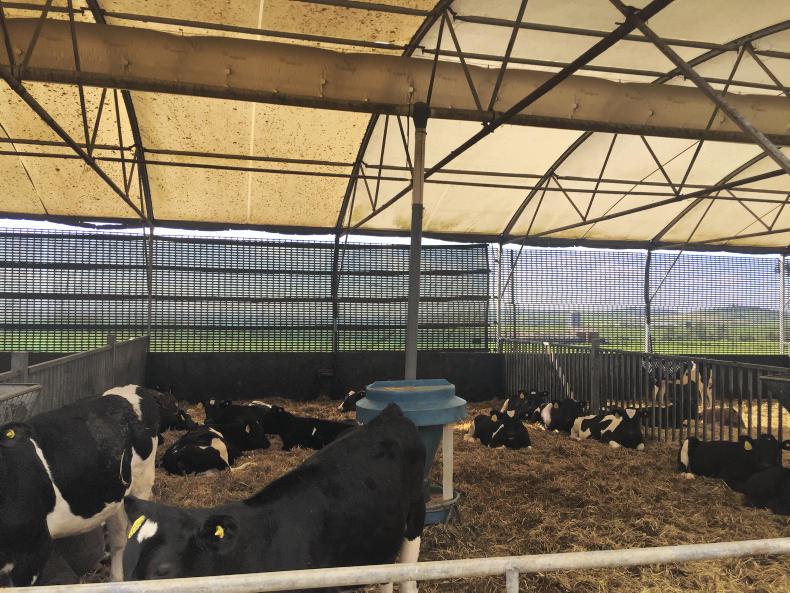
There are fans and mechanical ventilation blowing air into the polytunnel.
This usually happens at 56 days of age but Rory says they will get extra time if some calves are considered to be growing slowly.
Calves are fed meal ad-lib through an auger system and are fed milk once a day. They are weighed every 10 days from day 42 to establish their daily liveweight gain (DLWG, target 0.8kg/day) and body weight. The team at Dourie Farm makes weaning and going to grass decisions based on DLGW and overall body weight.
Rory wants them to be growing at 0.8kg/day and be 100kg LWT before going to grass. This usually occurs at 10 to 12 weeks old. Milk is pumped to the calf house and fed through Stallion feeders.
The structure comprises three polytunnels. There are two wide tunnels over the calf pens, with a smaller tunnel over the central passage. The Irish Farmers Journal visited the farm on a sunny day in late May this year and while I expected the tunnel to be warm and stuffy, it was actually the opposite.
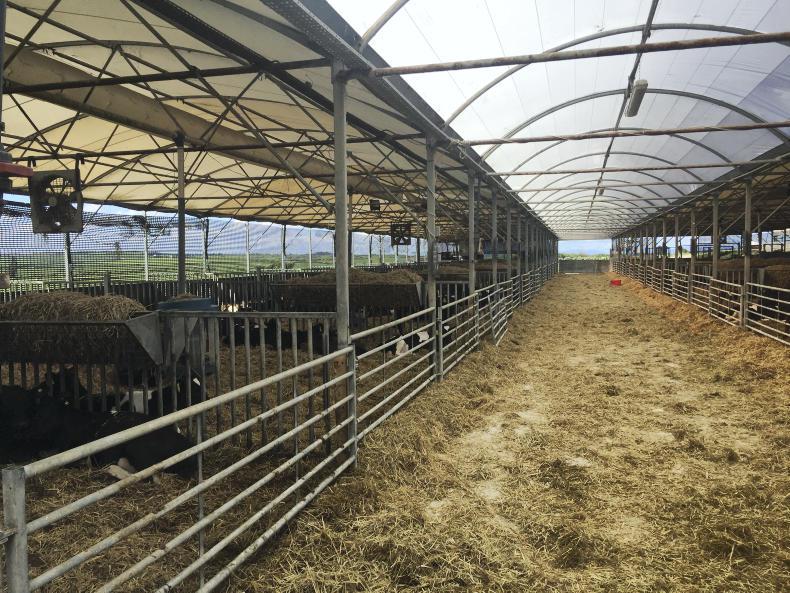
The polytunnel holds 400 calves with 18 calves per pen.
There are two electric fans at the gable end with an overhead duct running the length of the shed. This creates a natural stack effect and pushes stale air out the mesh sides. The mechanical ventilation keeps the building fresh and airy. That, and ample sunlight, gives a nice, bright feel to the space.
“I’m very happy with what we have. The design works. Calves are healthy and thankfully we get very little disease or sickness.
“We keep the heifer calves in the tunnel for a good while longer than most people would. They don’t go out until the maiden heifers have been served in May, so the calves are eating meal and straw ad-lib before they go out to grass. Transition to grass is the highest risk time and by May the weather is more consistent and we have time to concentrate on the calves at this key stage in their life,” Rory says.
The overall structure measures 70m by 24m and was built in 2010 at a cost of £120,000 excluding the cost of ventilation which was £6,000.
When designing another shed I would use roof vents to create a stack effect
At today’s exchange rate this works out at €138,000 including the cost of ventilation but excluding the cost of internal penning, etc. This works out at €345 per calf space.
“When designing another shed I would use roof vents to create a stack effect. The Magdek fans and tunnel compensate for the lack of roof vent. However, for many years, we did not have the ventilation equipment and we had little trouble. The air comes in the sides and out the sides.
We suffer from low-level pneumonia and have few if any cases of scour
“We have two labour units working approximately 40 hours per week until weaning. High care and very high attention to detail is key to our success. We lost four calves from arrival in the shed to departure from the shed. We suffer from low-level pneumonia and have few if any cases of scour,” Rory says.
Bryan Gibson,
New Zealand
Bryan and his wife Tesha are milking 440 cows near Taupo in the North Island. They recently took over the New Zealand Farmers Twitter account where they explained their system of calf rearing. Again, a polytunnel is featured.
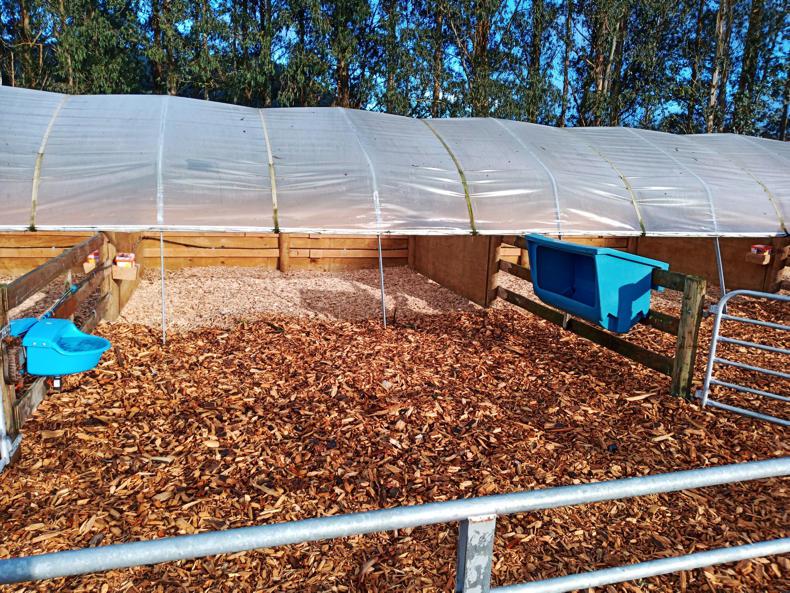
The stanchions have to be raised when the polytunnel is cleaned out at the end of the season. Bryan says it takes four hours to clean out and replace woodchip.
The facility is 32m long with eight pens measuring 4m wide. Only one-third of each pen is covered by the polytunnel, with an 8m by 4m outdoor run and 4m by 4m covered section. Bryan puts 16 calves into each pen, so the facility is capable of comfortably housing 128 calves.
The polytunnel part is quite low, so the sides need to be lifted when the woodchip is cleaned out.
There is no mechanical ventilation, but the calves can self-regulate their own temperature by deciding to go inside or outside. However, ventilation could be an issue on warm, wet days. Like most farms in New Zealand, timber boarding separates the pens.
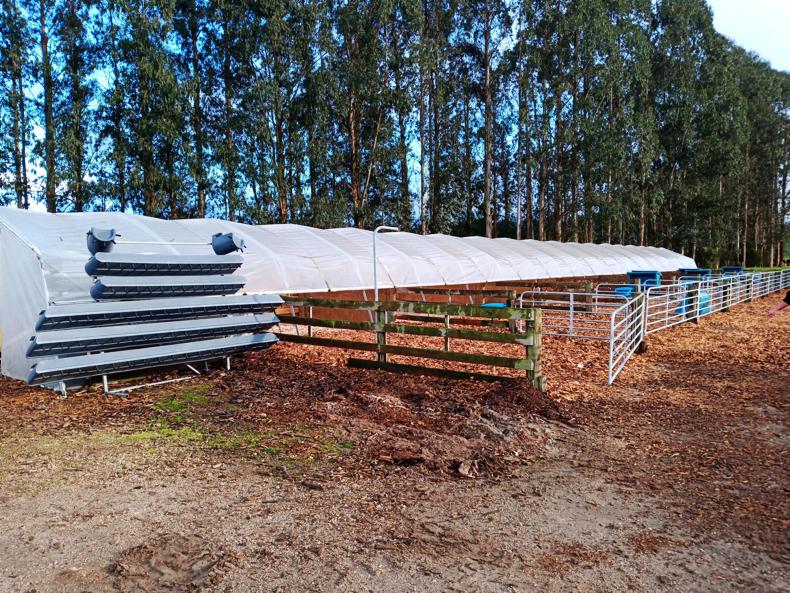
The polytunnel on Bryan Gibson's farm is capable of housing 128 calves.
The calves are fed once a day using 16-teat individual feeders. Calves get access to ad-lib meal and are weaned at 13% of their mature liveweight or at around 65kg. Rather than feeding meal and hay/straw separately, Bryan is feeding a blend of pelleted meal and straw called “NMR Ready Rumen”. On weaning age and weaning weight, Bryan says he sees very little difference between lighter and heavier weaned calves, but the key is that calves are eating enough meal when they are weaned.
The calf house is cleaned out once, at the end of the season using a miniature loader.
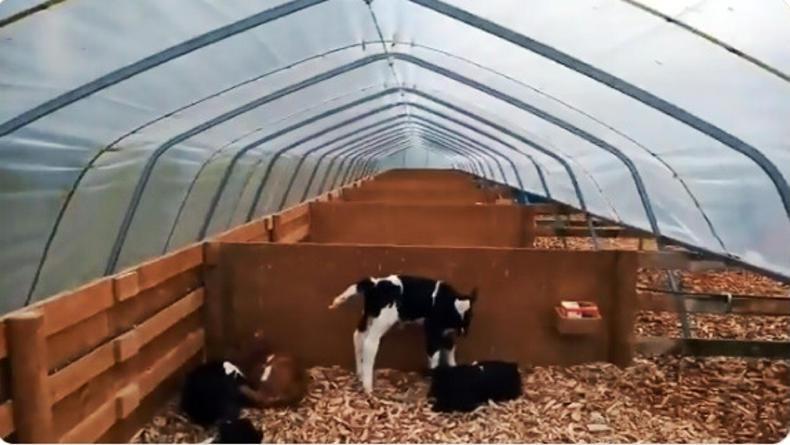
The covered section measures 4m x 4m with another 8m x 4m outdoors.
Bryan says it takes about four hours to clean out the old woodchip and replace it with fresh woodchip for next year. Most calf houses in New Zealand are steel lean-to style with the back of the open side facing away from the prevailing wind.
Colm Warren Polyhouses, based near Trim, Co Meath, indicates that a similar-sized polytunnel to Bryan Gibson’s would cost €4,580 plus VAT and supply only.
If you allow €10,000 for penning and flooring, the cost would be €14,580 which works out at €114 per calf space based on 128 calves.
As for Rory Christie’s calf house, a guide price of €67,175 excluding VAT was given for the structure (€4.44/square foot). This price would not include any penning or flooring.
The company said the final price for both designs would depend on the type of structure, style, finish, site details and height required.
Read more
Dairy management: milk liners, reseeding and cutting silage
IGA Summer Tour: an English lesson on dairy conversion in Westmeath
Over the next few weeks, the Irish Farmers Journal will run a series of articles on calf care, looking at housing facilities and rearing options. The focus will primarily be on relatively low-cost and low labour input that maximise calf welfare and performance. Not all options will suit everyone, but the purpose is to raise awareness and get the conversation on calf housing started in time for next spring. This week, we are looking at polytunnel calf houses.
Rory is currently milking 1,400 cows in a spring-calving system near Newton Stewart in southwest Scotland. A polytunnel was built for calves in 2010. The structure is big, capable of housing 400 calves in 22 pens. Calves start off in groups of six and when they are drinking well, they are grouped in pens of 18 and are fed 5.5l of milk per day.
When calves hit 60kg liveweight (mostly Jersey crossbred calves) they are weaned off milk.

There are fans and mechanical ventilation blowing air into the polytunnel.
This usually happens at 56 days of age but Rory says they will get extra time if some calves are considered to be growing slowly.
Calves are fed meal ad-lib through an auger system and are fed milk once a day. They are weighed every 10 days from day 42 to establish their daily liveweight gain (DLWG, target 0.8kg/day) and body weight. The team at Dourie Farm makes weaning and going to grass decisions based on DLGW and overall body weight.
Rory wants them to be growing at 0.8kg/day and be 100kg LWT before going to grass. This usually occurs at 10 to 12 weeks old. Milk is pumped to the calf house and fed through Stallion feeders.
The structure comprises three polytunnels. There are two wide tunnels over the calf pens, with a smaller tunnel over the central passage. The Irish Farmers Journal visited the farm on a sunny day in late May this year and while I expected the tunnel to be warm and stuffy, it was actually the opposite.

The polytunnel holds 400 calves with 18 calves per pen.
There are two electric fans at the gable end with an overhead duct running the length of the shed. This creates a natural stack effect and pushes stale air out the mesh sides. The mechanical ventilation keeps the building fresh and airy. That, and ample sunlight, gives a nice, bright feel to the space.
“I’m very happy with what we have. The design works. Calves are healthy and thankfully we get very little disease or sickness.
“We keep the heifer calves in the tunnel for a good while longer than most people would. They don’t go out until the maiden heifers have been served in May, so the calves are eating meal and straw ad-lib before they go out to grass. Transition to grass is the highest risk time and by May the weather is more consistent and we have time to concentrate on the calves at this key stage in their life,” Rory says.
The overall structure measures 70m by 24m and was built in 2010 at a cost of £120,000 excluding the cost of ventilation which was £6,000.
When designing another shed I would use roof vents to create a stack effect
At today’s exchange rate this works out at €138,000 including the cost of ventilation but excluding the cost of internal penning, etc. This works out at €345 per calf space.
“When designing another shed I would use roof vents to create a stack effect. The Magdek fans and tunnel compensate for the lack of roof vent. However, for many years, we did not have the ventilation equipment and we had little trouble. The air comes in the sides and out the sides.
We suffer from low-level pneumonia and have few if any cases of scour
“We have two labour units working approximately 40 hours per week until weaning. High care and very high attention to detail is key to our success. We lost four calves from arrival in the shed to departure from the shed. We suffer from low-level pneumonia and have few if any cases of scour,” Rory says.
Bryan Gibson,
New Zealand
Bryan and his wife Tesha are milking 440 cows near Taupo in the North Island. They recently took over the New Zealand Farmers Twitter account where they explained their system of calf rearing. Again, a polytunnel is featured.

The stanchions have to be raised when the polytunnel is cleaned out at the end of the season. Bryan says it takes four hours to clean out and replace woodchip.
The facility is 32m long with eight pens measuring 4m wide. Only one-third of each pen is covered by the polytunnel, with an 8m by 4m outdoor run and 4m by 4m covered section. Bryan puts 16 calves into each pen, so the facility is capable of comfortably housing 128 calves.
The polytunnel part is quite low, so the sides need to be lifted when the woodchip is cleaned out.
There is no mechanical ventilation, but the calves can self-regulate their own temperature by deciding to go inside or outside. However, ventilation could be an issue on warm, wet days. Like most farms in New Zealand, timber boarding separates the pens.

The polytunnel on Bryan Gibson's farm is capable of housing 128 calves.
The calves are fed once a day using 16-teat individual feeders. Calves get access to ad-lib meal and are weaned at 13% of their mature liveweight or at around 65kg. Rather than feeding meal and hay/straw separately, Bryan is feeding a blend of pelleted meal and straw called “NMR Ready Rumen”. On weaning age and weaning weight, Bryan says he sees very little difference between lighter and heavier weaned calves, but the key is that calves are eating enough meal when they are weaned.
The calf house is cleaned out once, at the end of the season using a miniature loader.

The covered section measures 4m x 4m with another 8m x 4m outdoors.
Bryan says it takes about four hours to clean out the old woodchip and replace it with fresh woodchip for next year. Most calf houses in New Zealand are steel lean-to style with the back of the open side facing away from the prevailing wind.
Colm Warren Polyhouses, based near Trim, Co Meath, indicates that a similar-sized polytunnel to Bryan Gibson’s would cost €4,580 plus VAT and supply only.
If you allow €10,000 for penning and flooring, the cost would be €14,580 which works out at €114 per calf space based on 128 calves.
As for Rory Christie’s calf house, a guide price of €67,175 excluding VAT was given for the structure (€4.44/square foot). This price would not include any penning or flooring.
The company said the final price for both designs would depend on the type of structure, style, finish, site details and height required.
Read more
Dairy management: milk liners, reseeding and cutting silage
IGA Summer Tour: an English lesson on dairy conversion in Westmeath






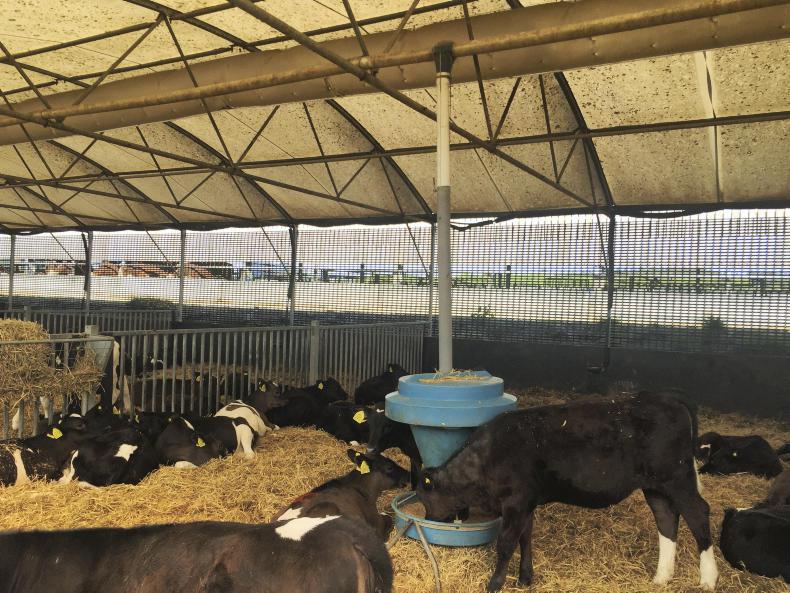




 This is a subscriber-only article
This is a subscriber-only article










SHARING OPTIONS: